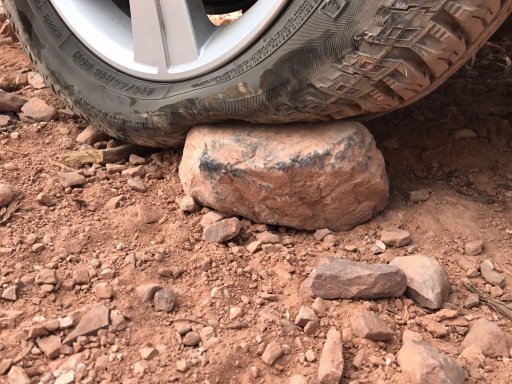I generally air down to 20 psi because that seems to be the popular pressure for most members of my club. I remember 12 was considered the minimum to keep the beads seated in the old bias ply days, but I honestly don't know what is considered a minimum on steel belted tires. I have been as low as 16 once or twice but I couldn't feel a difference over 20. So I just run 20 now.
Airing down.
- Thread starter WrightRunner
- Start date
-
Guest, we are migrating the site today. There may be interruption of service.
I normally air my DuraTracs down to 18PSI but may vary that as conditions demand. Weight load, surface and weather all play a part in choosing the appropriate pressure.
I run 315/75 r16 maxxis MT's on stock rims and I air down to 16. With the extra weight of aftermarket bumbers, winch and gear, I get enough sidewalk flex when I'm in the rocks. The prob I'm trying to avoid is peeling a tire off the rim when sliding sideways into a rut or running really off camber trails.

Member III
Usually air down to something in the order of ca.12 psi for "general air-down purposes".
However, as many of the thread articles above correctly state, it all depends on a number of factors.
(weight of vehicle, weather conditions, road conditions, age / dimension / tread depth & tread type / tire composition / type, degree of "ride softness" required, driver experience, etc.).
Driving in Norway an Iceland in winter, its good to reduce the air and gain a larger / softer footprint with each wheel.
Each occasion is unique, but a general air down to ca.12 PSI seems to work fine in most cases.
Driving over sharp lava in Iceland, we sometime go down to ca.8-10 PSI
Not had any issues with it to date :)
I have even seen air down to ca.2-5 PSI when driving on soft / slushy snow and glaciers.
I think common sense plays a key role in this decision.
If you have taken too much out, you can always refill (as long as you have compressor / air source)
Instinct and gut feeling also play a key role - if it doesn't feel quite right, adjust and try again.
And when the road conditions have improved / back to normal roads, re-inflate your tires ASAP.
Don't keep running on deflated tires on normal roads or at speed - it will significantly damage the tire and could cause potential accidents.
There are a lot of interesting and informative articles on the internet covering this subject,
but nothing beats the realtime experience.
Happy Driving !
However, as many of the thread articles above correctly state, it all depends on a number of factors.
(weight of vehicle, weather conditions, road conditions, age / dimension / tread depth & tread type / tire composition / type, degree of "ride softness" required, driver experience, etc.).
Driving in Norway an Iceland in winter, its good to reduce the air and gain a larger / softer footprint with each wheel.
Each occasion is unique, but a general air down to ca.12 PSI seems to work fine in most cases.
Driving over sharp lava in Iceland, we sometime go down to ca.8-10 PSI
Not had any issues with it to date :)
I have even seen air down to ca.2-5 PSI when driving on soft / slushy snow and glaciers.
I think common sense plays a key role in this decision.
If you have taken too much out, you can always refill (as long as you have compressor / air source)
Instinct and gut feeling also play a key role - if it doesn't feel quite right, adjust and try again.
And when the road conditions have improved / back to normal roads, re-inflate your tires ASAP.
Don't keep running on deflated tires on normal roads or at speed - it will significantly damage the tire and could cause potential accidents.
There are a lot of interesting and informative articles on the internet covering this subject,
but nothing beats the realtime experience.
Happy Driving !

Off-Road Ranger I
I run my KO2's at 15 psi in the sand (and fairly unloaded). 20psi for trails. On the street, I run a max of around 40, even though the tires can take 80.
Safe air down PSI is really dependent on vehicle, vehicle load, tire Load Rating, wheel type/design, terrain type, and vehicle speed.
I typically air down to about 12 PSI in the big rocks and 18 PSI on the trails, deep snow and sand. Fire roads or snow/ice covered roads could be around 24 PSI to spread the tread block and keep things plush in the cab.
I typically air down to about 12 PSI in the big rocks and 18 PSI on the trails, deep snow and sand. Fire roads or snow/ice covered roads could be around 24 PSI to spread the tread block and keep things plush in the cab.

Steward I
- 5,937
- First Name
- Michael
- Last Name
- Bogan
- Member #
-
8750
- Ham/GMRS Callsign
- WRJC877
I don't adjust my air pressure unless absolutely necessary.Just curious to what everyone airs down to with NON beadlock wheels. I'v got BFG 285 /75 /17 KO2'S .
First thing I do when I hit a trailhead is air down. Comfort alone is worth the time for me and I don't know what's ahead. It can get nasty fast. Also, riding street pressures on washboard roads is tantamount to torture. All the other benefits, like puncture resistance and increased traction / capability you all already know.
I'm currently running very small stock sized tires, but airing them down allows me to travel comfortably off road, and I've taken my fully loaded Forester on roads I absolutely know I could not have done without airing down.
I can't wait to start running larger tires with more sidewall and a smaller wheel (from 16" to 15"). Currently running 215/65/16 Yokohama Geolandar G015 aired down to 16-18 PSI on sand and the trails, respectively. Fully loaded in back I run 20PSI rear on the trails.

I'm currently running very small stock sized tires, but airing them down allows me to travel comfortably off road, and I've taken my fully loaded Forester on roads I absolutely know I could not have done without airing down.
I can't wait to start running larger tires with more sidewall and a smaller wheel (from 16" to 15"). Currently running 215/65/16 Yokohama Geolandar G015 aired down to 16-18 PSI on sand and the trails, respectively. Fully loaded in back I run 20PSI rear on the trails.


Influencer II
Running your tires aired down on dirt roads helps reduce the terrible washboard effects. It worth it for just that!
Sent from my SM-N910V using OB Talk mobile app
Sent from my SM-N910V using OB Talk mobile app
Does airing down significantly affect clearance? I went for a bit of crawling/mud slinging last weekend with camping gear on board and was worried that airing down would lower my clearance at the axles and so I left them at 30-32 psi. The ride was definitely rough, but I was able to get over most obstacles. Is there a trade-off here?
The loss in clearance is negligible vs. the comfort and control you get airing down. You gain more traction aired down in most situations. I generally air down to 15 psi for most FS roads, snow, mud what have you.
2500 suburban and I aired down to about 30psi on 3 tires, 20psi on one (strictly a strategic decision, I swear!). I probably could have gone down to 20psi all around but one thing to remember is when you air down at a trailhead your tires are likely hot. We camped overnight and the tires were down about 5 psi lower at freezing temps.
Needed the added rubber on the ground for the icy hills on the trail and it really helped.

Sent from my LG-H873 using Tapatalk
Needed the added rubber on the ground for the icy hills on the trail and it really helped.

Sent from my LG-H873 using Tapatalk
I'm running 275 70R17 and have been going down to 18psi. Although I started at 25 then 20 and found 18 to be good in most conditionsJust curious to what everyone airs down to with NON beadlock wheels. I'v got BFG 285 /75 /17 KO2'S .
I have 31" x 10.5" x 15" BFG KO2s and if I am just going wheeling I will air them down to around 13psi.
That on road psi is extremely high. I run my 35" BFG at around 30 psi on the street (12-15 on the trail). For on road pressures, check out the "chalk test". The ride will be so much smoother if you let even 5psi out of those Toyos, there is no need to run 40.I run 18psi on my JKUR. My 35x 12.5 Toyo's recommend 45psi min, but I usually keep them at 40 if I'm on pavement.

Member III
Tire construction has a lot to do with it to I run cooper st Maxx on my sequoia(e rated ) and have to get down around 15 psi to get them to squat , on my tahoe with mtrs (c load range ) they start to squat at 20 . You will have to experiment to see what works for your rig .

Off-Road Ranger I
I agree, my 2dr's Grabbers run at 32psi, and I like the ride of the lower psi. And that 45 psi is supposedly the low end. I'll have to bring chalk down to town, no pavement around here for a good hour.That on road psi is extremely high. I run my 35" BFG at around 30 psi on the street (12-15 on the trail). For on road pressures, check out the "chalk test". The ride will be so much smoother if you let even 5psi out of those Toyos, there is no need to run 40.

Member III
I air my Nitto Terra Grapplers down to 25 psi from the recommended 35 psi on the pavement. I know many people go lower and I wouldn't hesitate to go down to 20 psi but haven't had any issues at 25 psi thus far (and thus far is 30+ years of off roading in the AZ desert).
-Curtiss
-Curtiss





